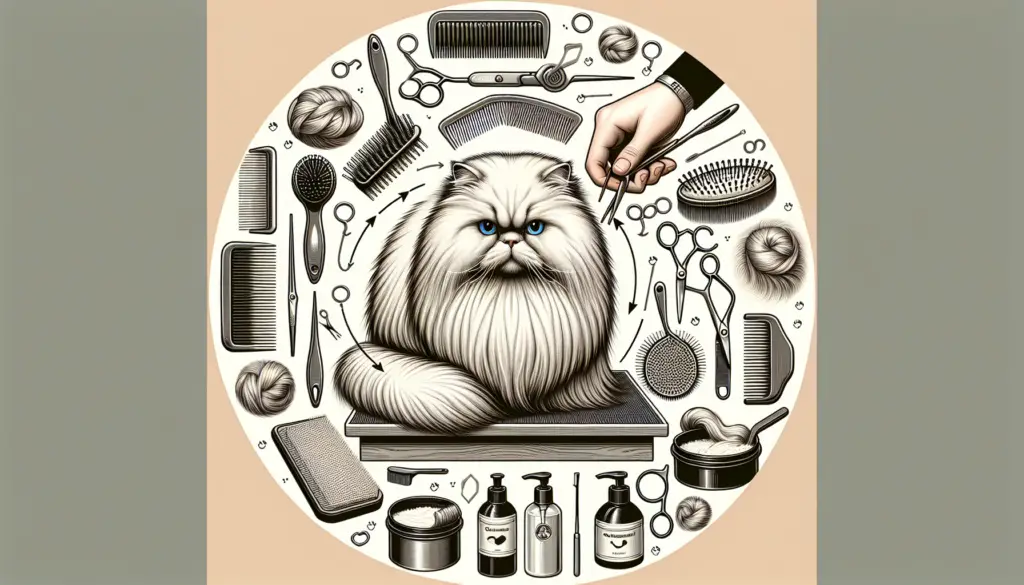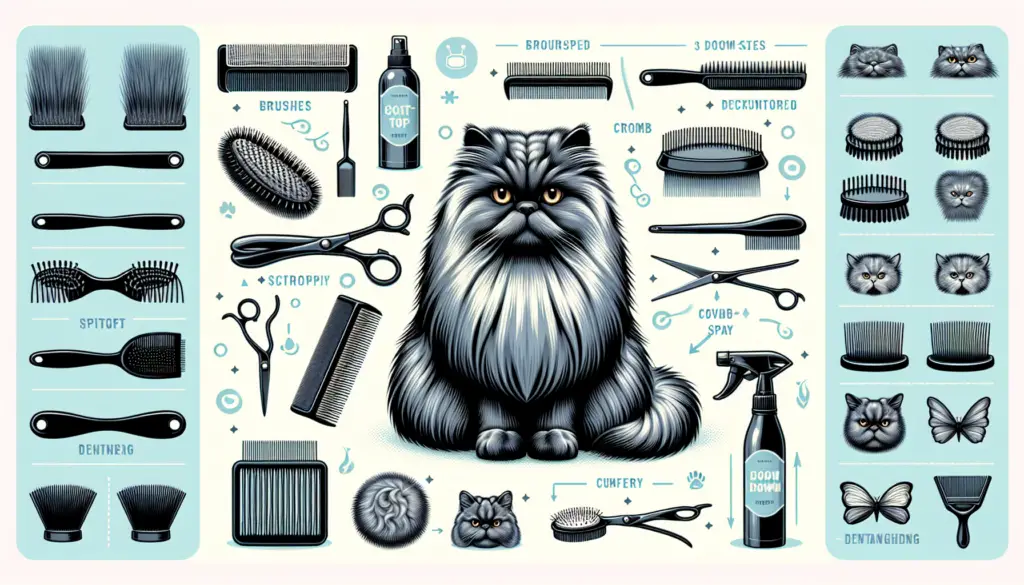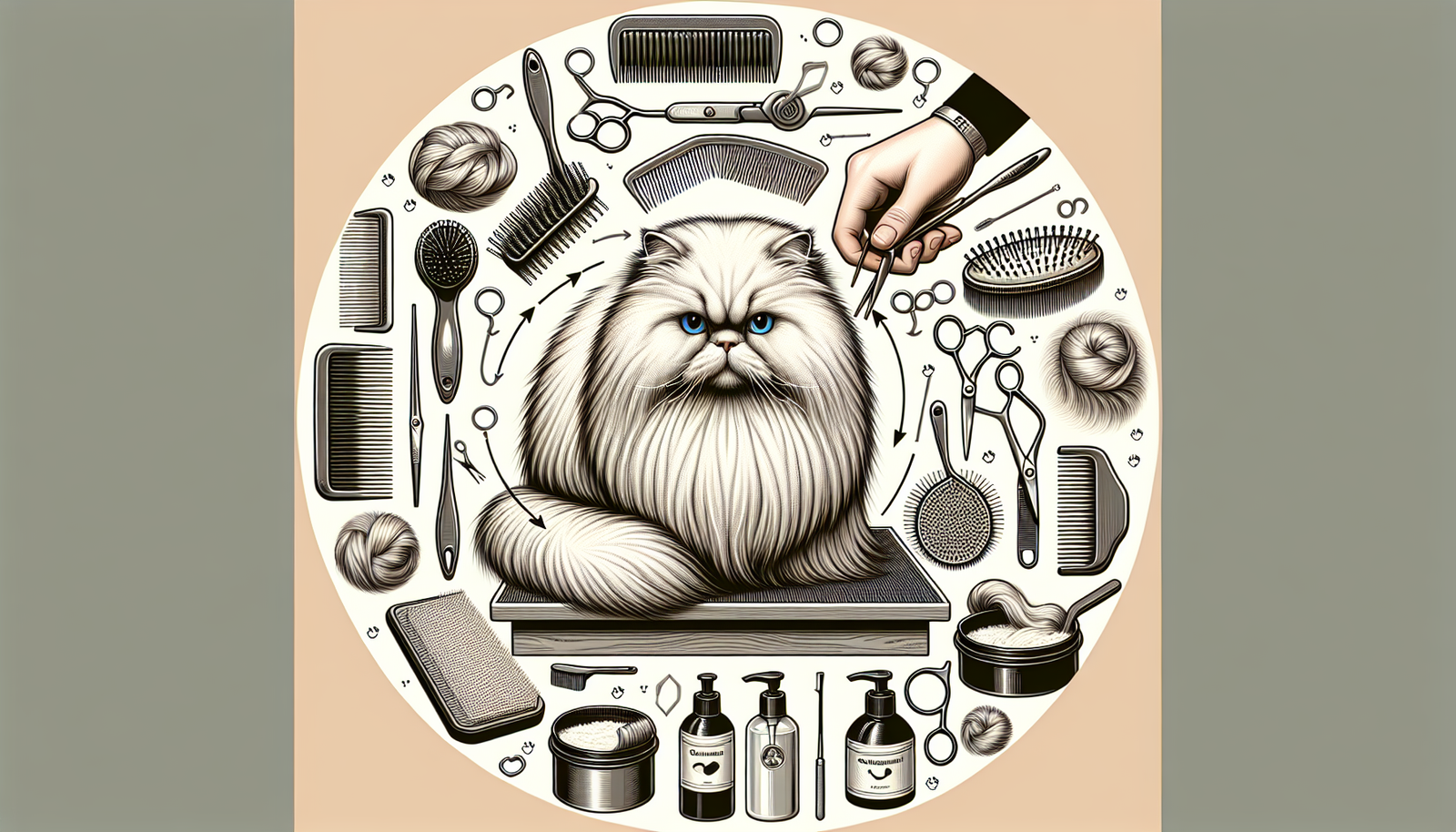Are you struggling to untangle the luscious fur of your beloved Persian cat? Look no further, for this ultimate guide is here to rescue you! Tangled fur can be a common challenge for Persian cat owners, but fear not, as we have compiled a set of simple and effective techniques to help you detangle your feline friend’s locks with ease. From gentle brushing techniques to the right tools and products, we’ve got you covered in this comprehensive guide on how to detangle a Persian cat. Say goodbye to snarls and hello to perfectly groomed fluffiness!

Preparing for Detangling
Gathering the necessary tools
Before you begin the process of detangling your Persian cat’s coat, it’s important to gather all the necessary tools. Make sure you have a wide-toothed comb specifically designed for long-haired cats. Additionally, have some treats on hand as a reward for your cat’s cooperation during the grooming session.
Creating a comfortable environment
To ensure a successful detangling session, it’s crucial to create a comfortable environment for your cat. Find a quiet, well-lit room where you can work without distractions. Use a soft blanket or towel to provide a comfortable surface for your cat to sit or lie on during the grooming process. If your cat enjoys a specific area or has a favorite blanket, try to accommodate their preferences to help them feel at ease.
Ensuring the cat is calm and relaxed
Detangling can be a lengthy process, so it’s important to ensure that your Persian cat is calm and relaxed before you begin. Spend some time playing or engaging in gentle petting to help your cat unwind. If you notice signs of anxiety or stress, such as flattened ears or a hunched posture, give your cat some time to relax before proceeding with the grooming session. It’s crucial to prioritize your cat’s emotional wellbeing throughout the process.
Understanding Your Persian Cat’s Coat
Recognizing the characteristics of a Persian cat’s coat
Persian cats are known for their luscious, long coats that require regular maintenance to keep them tangle-free. Understanding the characteristics of a Persian cat’s coat is important before delving into the detangling process. Persian cats have a dense and luxurious double coat, consisting of a thick undercoat and a long, silky topcoat. This beautiful coat is prone to tangling and matting, making regular grooming a necessity.
Identifying common tangles and mats
Tangles and mats are a common occurrence in Persian cats’ coats. Tangles are twisted clumps of hair that can form anywhere on the coat. Mats, on the other hand, are tightly packed tangles that have become matted and can be more challenging to remove. They often occur in areas where there is friction, such as behind the ears, under the armpits, or around the tail. Identifying these tangles and mats early on will help prevent them from getting worse and causing discomfort for your cat.
Knowing the importance of regular grooming
Regular grooming is essential for maintaining a Persian cat’s coat and preventing tangles from forming. Grooming not only keeps the coat looking beautiful but also promotes healthy skin and prevents skin issues. By establishing a routine grooming schedule, you can minimize the risk of tangles and mats and ensure your cat’s coat remains in optimal condition. Consistency is key when it comes to preventing and managing tangles.
Step-by-Step Detangling Process
Starting with gentle touch and inspection
Begin the detangling process by approaching your Persian cat with a gentle touch. Allow your cat to sniff and explore the tools you will be using, assuring them that they are safe. Start by softly petting your cat’s back, slowly moving towards the area with tangles. This gentle approach helps your cat feel more comfortable and prepared for the grooming session.
As you pet, inspect the coat for any visible tangles or mats. Take note of their location and severity so you can prioritize the areas that require immediate attention. Patience is key during this step as some tangles may be more challenging to spot, especially in the deeper layers of the fur.
Using a comb designed for long-haired cats
Invest in a high-quality, wide-toothed comb specifically designed for long-haired cats. These combs are designed to gently remove tangles without causing pain or discomfort. Start by combing through the fur in the direction of hair growth, using gentle strokes. Work your way through the entire body, paying extra attention to areas prone to tangles.
Working through small tangles and mats
For small tangles or mats, hold the fur close to the skin to prevent pulling and discomfort. Starting from the bottom of the tangle, gently work your way up using the wide-toothed comb. Avoid using excessive force or yanking on the hair, as this can cause pain and create an unpleasant grooming experience for your cat.
Addressing larger or more stubborn tangles
Larger, more stubborn tangles or mats may require additional care. If the tangle cannot be loosened with the comb, use your fingers or a mat splitter to carefully separate the hair. Take your time and work through the tangle slowly, being mindful of any signs of discomfort or pain from your cat.
Taking breaks to prevent stress
Detangling can be a time-consuming process, so it’s important to take occasional breaks to prevent stress and discomfort for both you and your cat. Use these breaks to offer your cat treats, engage in gentle play, or simply allow them to relax for a few minutes. These breaks will not only keep your cat calm but also allow you to regroup and approach the next tangle with a fresh perspective.
Rewarding your cat for cooperation
Throughout the detangling process, remember to reward your cat for their cooperation. Positive reinforcement, such as offering treats or verbal praise, will help create a positive association with grooming and make future sessions easier. By rewarding your cat’s good behavior, you are reinforcing their trust in you and making detangling a more pleasant experience for both of you.
Dealing with Difficult Situations
Managing fear or anxiety in your cat
Some Persian cats may experience fear or anxiety during the detangling process. If you notice signs of distress, such as excessive vocalization, trembling, or hiding, it’s important to address these emotions. Take a step back and reassess the situation. Do not force your cat to continue the grooming session if they are clearly uncomfortable. Instead, offer reassurance, take a break, and consider rescheduling the session for a time when your cat is more relaxed.
Seeking professional help if necessary
If your cat’s coat is severely matted or if you are uncomfortable detangling their coat yourself, it may be necessary to seek professional help. Professional groomers have the experience and expertise to handle challenging tangles and mats without causing pain or distress to your cat. They can also provide advice on proper grooming techniques and recommend helpful products to maintain a tangle-free coat.
Considering sedation as a last resort
In extreme cases where detangling is challenging or stressful for both you and your cat, sedation may be considered as a last resort. This option should only be used under the guidance and supervision of a veterinarian. Sedation can help your cat remain calm during the grooming process, ensuring their safety and minimizing the risk of accidental injuries. However, it’s important to thoroughly discuss the risks and benefits with your vet and weigh the necessity of sedation against other alternatives.

Maintaining a Tangle-Free Coat
Establishing a regular grooming routine
Once you have successfully detangled your Persian cat’s coat, it’s important to establish a regular grooming routine. Consistency is key, as regular grooming helps prevent tangles from forming and keeps your cat’s coat healthy. Set aside specific times each week for grooming, making it a positive and enjoyable experience for your cat.
Brushing techniques for preventing tangles
In addition to regular grooming, brushing is an essential technique for preventing tangles in your Persian cat’s coat. Using a soft-bristled brush, gently brush your cat’s fur in the direction of hair growth. This helps distribute natural skin oils, remove loose hair, and prevent matting. Focus on areas prone to tangles, such as the armpits, chest, and behind the ears.
Using detangling sprays or conditioners
Detangling sprays or conditioners can be valuable tools in preventing tangles and maintaining a tangle-free coat. These products help to soften the fur, making it easier to comb through and reducing the risk of tangles forming. When using detangling sprays, always follow the product instructions and avoid spraying directly on your cat’s face or sensitive areas.
Keeping your cat’s coat clean and healthy
Maintaining a tangle-free coat also involves keeping your Persian cat’s coat clean and healthy. Regular bathing, using cat-friendly shampoo, can help remove any dirt or debris that may contribute to tangles. Remember to dry your cat’s coat thoroughly after bathing to prevent moisture from leading to matting. Additionally, keeping your cat’s coat moisturized with a cat-safe conditioner can help maintain its softness and minimize the risk of tangles.
Preventing Tangles in the Future
Trimming long hair on specific areas
Another effective way to prevent tangles is by keeping the long hair on specific areas trimmed. For example, trimming the hair around the armpits, behind the ears, and around the tail can minimize the chances of tangles forming in these high-friction areas. However, be cautious when trimming your cat’s hair and ensure that you are using appropriate grooming tools to avoid causing any accidental injuries.
Avoiding common tangle triggers
Certain activities and objects can act as tangle triggers for your Persian cat. Tangle triggers can include playing in brushy areas, wearing collars or harnesses with rough edges, or even rubbing against rough surfaces. By identifying and avoiding these triggers, you can minimize the risk of tangles forming and reduce the frequency of detangling sessions.
Maintaining a healthy diet for your cat
Believe it or not, your cat’s diet can impact the health of their coat and contribute to the prevention of tangles. Ensure that your Persian cat is receiving a balanced and nutritious diet that supports healthy skin and coat. Consult with your veterinarian to determine the best diet for your cat’s specific needs and ask about any dietary supplements that may promote a healthier coat.
Regular vet check-ups for preventive care
Regular veterinary check-ups are crucial for preventive care and overall well-being. During these check-ups, your veterinarian can assess your cat’s coat condition, address any skin issues, and provide guidance on maintaining a tangle-free coat. By addressing any potential concerns or issues early on, you can minimize the risk of tangles and other coat-related problems.
Understanding the Risks
Potential risks associated with detangling
While detangling is important for maintaining a healthy coat, it’s essential to understand the potential risks involved. Pulling or yanking on your cat’s hair can cause discomfort, pain, and even skin injuries. Using inappropriate tools or techniques can also lead to accidental injuries. Be mindful of your cat’s reactions and always approach detangling with a gentle touch and a patient attitude.
Monitoring for signs of stress or discomfort
Throughout the detangling process, it’s crucial to monitor your cat for signs of stress or discomfort. These signs may include excessive vocalization, panting, restlessness, or attempts to escape. If you notice any of these signs, take a break, offer reassurance, and reevaluate your approach. Your cat’s comfort and safety should always be the top priority.
Taking precautions to minimize risks
To minimize the risks associated with detangling, take necessary precautions. Always use appropriate grooming tools and avoid using excessive force or pulling on tangles. Ensure that you are working in a well-lit and comfortable environment, free from distractions. By being proactive and cautious, you can help create a safe and pleasant grooming experience for both you and your cat.
Helpful Tips and Tricks
Requesting assistance if needed
If you find yourself struggling with the detangling process or if your cat’s coat is severely matted, don’t hesitate to seek assistance. Reach out to a professional groomer or consult with your veterinarian for guidance. They can provide invaluable advice, demonstrate proper detangling techniques, and help you navigate any challenges you may encounter.
Using treats or positive reinforcement
Treats and positive reinforcement can go a long way in ensuring a successful detangling session with your Persian cat. Reward your cat with treats or praise for their cooperation and good behavior throughout the grooming process. This positive reinforcement creates a positive association with grooming and makes future sessions more enjoyable for both you and your cat.
Working slowly and patiently
Remember, detangling a Persian cat’s coat is not a race. Take your time and work slowly and patiently through each tangle. Rushing or applying excessive force can lead to painful tugging and cause more harm than good. By maintaining a calm and patient approach, you can effectively detangle your cat’s coat while keeping them comfortable and relaxed.
Trimming nails before detangling
Trimming your cat’s nails before starting the detangling process can help prevent accidental scratching or injuries. Cats’ nails can be sharp, and the grooming process may cause them to react defensively if they feel uncomfortable or in pain. By ensuring that their nails are properly trimmed, you can minimize the risk of accidental scratching and create a safer environment for both you and your cat.
Using a grooming table or elevated surface
Using a grooming table or an elevated surface can make the detangling process more manageable for both you and your cat. These surfaces provide better visibility and access to your cat’s coat, reducing strain on your back and allowing you to groom with ease. While a grooming table is not necessary, it can be a helpful investment for regular grooming and maintenance.
Special Considerations for Persian Kittens
Starting grooming early to build familiarity
When it comes to Persian kittens, it’s crucial to start grooming early to build familiarity and comfort. Introduce your kitten to grooming tools, such as combs and brushes, from a young age. Make grooming a positive experience by offering treats, playing soothing music, or engaging in gentle play during the grooming sessions. By establishing a routine early on, you can help your kitten develop a positive association with grooming and make future detangling sessions easier.
Using softer brushes or combs
As Persian kittens have more delicate skin and fur, it’s important to use softer brushes or combs specifically designed for kittens. These gentler tools will help prevent discomfort or irritation while detangling. Start with softer brushes or combs and gradually transition to regular grooming tools as your kitten grows older and the fur becomes more resilient.
Using kitten-friendly detangling products
When detangling a Persian kitten’s coat, opt for kitten-friendly detangling products. These products are formulated specifically for kittens’ sensitive skin and are generally milder and less harsh than adult cat products. Always follow the instructions provided and avoid using any products that may cause irritation or adverse reactions in your kitten.
Keeping sessions short and positive
Due to their young age and limited attention span, it’s important to keep grooming sessions with Persian kittens short and positive. Start with brief sessions and gradually increase the duration as your kitten becomes more comfortable and accustomed to the grooming process. Ensure that each session ends on a positive note, with treats and praise, to reinforce a positive association with grooming.
Summary
In summary, detangling a Persian cat’s coat requires careful preparation, understanding, and a patient approach. By gathering the necessary tools, creating a comfortable environment, and ensuring your cat’s calmness, you can lay the foundation for a successful detangling session. Understanding the characteristics of a Persian cat’s coat, recognizing common tangles and mats, and emphasizing the importance of regular grooming are key factors in maintaining a tangle-free coat.
The step-by-step detangling process includes starting with gentle touch and inspection, using a comb designed for long-haired cats, working through small tangles and mats, and addressing larger or more stubborn tangles. Taking breaks, rewarding your cat for cooperation, and dealing with difficult situations such as fear or anxiety are important aspects of the detangling process. Additionally, maintaining a tangle-free coat involves establishing a regular grooming routine, using proper brushing techniques, and keeping the coat clean and healthy.
Preventing tangles in the future requires trimming long hair on specific areas, avoiding common tangle triggers, maintaining a healthy diet for your cat, and regular veterinary check-ups for preventive care. It’s essential to understand the potential risks associated with detangling, monitor your cat for signs of stress or discomfort, and tak

